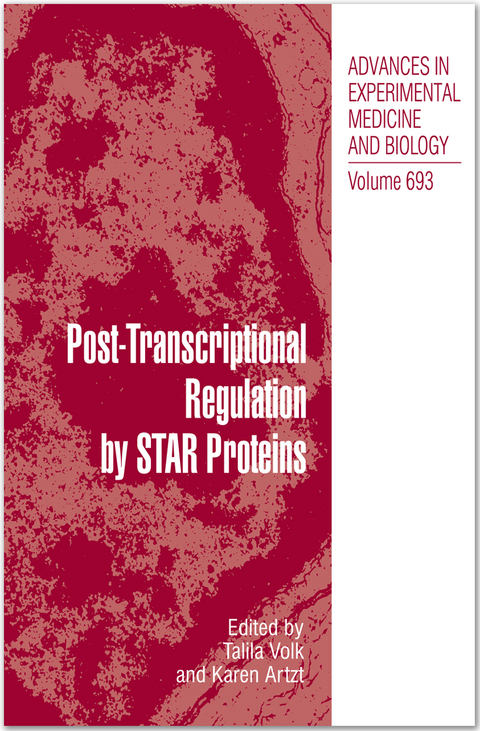
Post‑Transcriptional Regulation by STAR Proteins
Springer-Verlag New York Inc.
978-1-4899-7805-9 (ISBN)
This book aims to bring to the forefront a field that has been developing since the late 1990s called the STAR pathway for Signal Transduction and Activation of RNA. It is a signaling pathway that targets RNA directly; in contrast to the canonical signal kinase cascade transcription factor DNA RNA. It is proposed to allow quick responses to environment changes such as those necessary in many biological phenomenona such as the nervous system, and during development. The pathway is diagramed in Chapter 1, Figure1. This chapter is a historical introduction and general review with some new data on theoretical miRNAs binding sites and STAR mRNAs. In Chapter 2, Feng and Banks address the accumulating evidence that the RNA-binding activity and the homeostasis of downstream mRNA targets of STAR proteins can be regulated by phosphorylation in response to various extracellular signals. Then Ryder and Massi review the available information on the structure of the RNA binding STAR domain and provides insights into how these proteins discriminate between different RNA targets. Next Claudio Sette offers an overview of the post-translational modifications of STAR proteins and their effects on biological functions, followed by two chapters dedicated to in depth review of STAR function in spermatogenesis and in mammalian embryonic development. Chapters 7 and 8 discuss what can be learned from STAR proteins in non-mammalian species; in Drosophila and Gld-1 and Asd-2 in C. elegans. Next Rymond discusses the actual mech- ics of splicing with mammalian SF1."
Talila Volk is an associate professor in the field of Developmental Biology and the incumbent of the Sir Ernest B. Chain Professional Chair. Her major research interest is in tissue morphogenesis and organogenesis during embryonic development. She has been studying the function and activity of the STAR family member Held Out Wing (HOW) in the fruit fly Drosophila since 1999. She served as the chair for the Society of Developmental Biology in Israel (ISDB). Dr. Volk has gained her BSc from Tel‑Aviv University, and her MSc and PhD degrees from the Weizmann Institute of Science, Rehovot, Israel. Karen Artzt is an Ashbel Smith Professor Emeritus at the University of Texas at Austin where she directed a research laboratory for 20 years. There she was a member of the Section of Molecular Genetics and Microbiology. Prior to that she was an associate Member of the Memorial Sloan Kettering Cancer Center in New York. Her main research interests include developmental genetics with an emphasis on cancer biology. In collaboration with Tom Ebersole she identified and cloned the mouse gene quaking that was one of the founding members of the STAR family. Dr. Artzt received her academic degrees from Cornell university; a BA from the Ithaca campus and a PhD from the Medical College School of Graduate Sciences in New York City. In 1972 she spent a year as a postdoctoral fellow at the Pasteur Institute in Paris under the direction of the Nobel Prize winner, Francois Jacob.
Star Trek.- The Star Family Member.- Insights into the Structural Basis of RNA Recognition by Star Domain Proteins.- Post-translational Regulation of STAR Proteins and Effects on Their Biological Functions.- Expression and Functions of the Star Proteins Sam68 and t-star in Mammalian Spermatogenesis.- The Role of Quaking in Mammalian Embryonic Development.- Drosophila STAR Proteins.- C. Elegans Star Proteins, Gld-1 And Asd-2, Regulate Specific RNA Targets to Control Development.- The Branchpoint Binding Protein.- Reaching for the STARs.
| Erscheinungsdatum | 19.08.2017 |
|---|---|
| Reihe/Serie | Advances in Experimental Medicine and Biology ; 693 |
| Zusatzinfo | XVIII, 162 p. |
| Verlagsort | New York |
| Sprache | englisch |
| Maße | 178 x 254 mm |
| Themenwelt | Medizin / Pharmazie ► Medizinische Fachgebiete ► Pharmakologie / Pharmakotherapie |
| Medizin / Pharmazie ► Pharmazie | |
| Naturwissenschaften ► Biologie ► Humanbiologie | |
| Naturwissenschaften ► Biologie ► Zoologie | |
| Schlagworte | Artzt • nervous system • Protein • Regulation • Start • Volk |
| ISBN-10 | 1-4899-7805-4 / 1489978054 |
| ISBN-13 | 978-1-4899-7805-9 / 9781489978059 |
| Zustand | Neuware |
| Haben Sie eine Frage zum Produkt? |
aus dem Bereich


